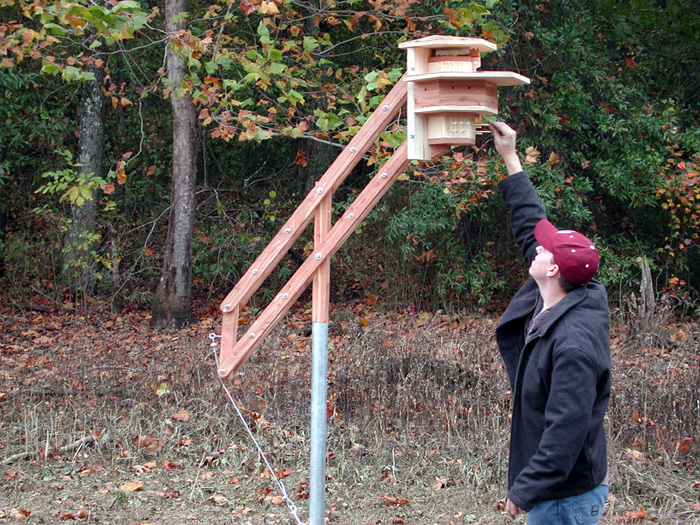Contact: Maridith Geuder

MSU architecture major Marshall Graves of Jackson with the bird dwelling he designed.
When not training to design the homes, businesses and public buildings of the future, students in one Mississippi State architecture class are adopting clients of a different feather.
A dozen of the university's upper-level architecture majors recently turned their creative energies to the creature comforts of some, well, creatures of the wild: wood ducks, screech owls, flycatchers, Carolina chickadees, kestrels, and prothonotary warblers, to be precise.
Directed by associate professor Michael Berk, the senior design project is among a number at the School of Architecture that involve students in hands-on building with social and environmental concerns.
With funding from the Mississippi Audubon Environmental Education Center at Holly Springs, Berk's class developed various proposals for a master plan and environmental education center for the public sanctuary known as Strawberry Plains. In additional to the theoretical work, they also designed and built bird habitats for the 2,500-acre site.
Berk said the annual class project was designed to thrust students into real-life situations for which they had no preconceived ideas. "They had to focus on a client as a complete unknown and approach design as a pure problem-solving situation," he explained.
"The students knew absolutely nothing about these particular birds when we started the project," Berk said. "They quickly had to research the species and become experts about migration, feeding habits, predators, habitat requirements, and a variety of other issues."
In the process, the future professionals addressed a range of architectural issues such as client needs, budget, project deadlines, limitation of materials, and location. Unlike working architects, though, they had to build and install their designs within a matter of weeks.
In constructing the units--some nearly 20 feet high--students were prohibited from using concrete, paint or pressure-treated wood. "The structures had to be completely compatible with the environment," Berk said.
As in the real world, the project's budget provided another constraint. Each two-person team was allocated $40 for materials, with Strawberry Plains contributing salvaged wood from outbuildings and fallen trees from the sanctuary.
Brandon Gowen, a fourth-year student from Corinth, said the project literally challenged students to--pun intended--"think outside the box." To do so, they had to consider such features as structure shape, nesting habits, entrance size, "and even the pitch of the roof."
Gowen said he and teammate Patrick Smith of Collierville, Tenn., completed a 15-foot-high dwelling with materials recovered from a dismantled barn. "This project gave me great confidence that I can design something that can actually be built and installed," he added.
That attitude, Berk observed, is one goal of the exercise.
"Students created drawings, computer models and large-scale wooden models as a way of investigating sustainable design principles for a proposed nature center," he said. "We also hope their ideas will help the Strawberry Plains Sanctuary establish criteria and develop questions as they prepare for their future growth and development."
Madge Lindsay, Strawberry Plains executive director, expressed appreciation to Berk and his students. She said their efforts benefited the state Audubon center on several levels.
"First, it was a great opportunity to learn from students studying architecture some uses for the site and to develop site plans for conservation programs," she said. "It also was rewarding to see them learn about conservation and about what birds need for habitat and nesting structures."
In addition to Gowen and Smith, other students involved in the semester project are Lena M. Coleman of Ridgeland; Stephens P. Daniel of Flora; L. Marshall Graves of Jackson; Wade D. Harder of Lynchburg, Tenn.; Leigh Ann Harris of Jackson, Tenn.; David E. Maxwell and Harrison L. Young of Starkville; Ryan S. Nichols of Guntersville, Ala.; Greg Pruitt of Oxford; and Jane R. Sanders of Greenville.